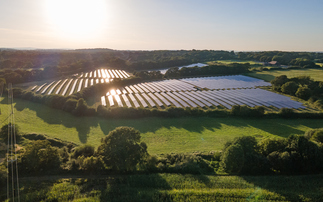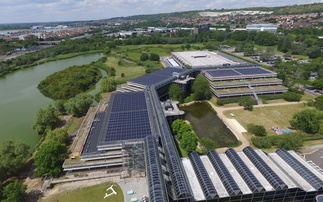Leonie Greene says the bottom-up solar revolution is a global story but worries DECC is still ignoring its potential
When the government unveiled its electricity market reform (EMR) delivery plan yesterday to drive billions of pounds of investment in low carbon power generation, it was shocking to discover it foresees a future with little utility solar power capacity installed for the next 16 years.
As 2013 draws to a close the UK sits on the fringes of the global top 10 for solar power production. In just three years half a million British homes (or other small roofs) have gone solar.
However, conspicuous by its absence in the UK is the mid/large solar roof market covering schemes upwards of 100kW right up to 5MW - the size of the Bentley car factory scheme, which is currently the largest roof scheme in the UK.
Climate Change Minister Greg Barker often says we could deliver his entire 22GW solar aspiration from a fraction of commercial and industrial roof space and the industry was delighted when last week he announced that 2014 would be the year to unlock this market.
But the devil will be in the detail, including the level of resourcing under the Levy Control Framework. The FIT needs to be restructured to allow very generous capacity triggers, particularly for 250kW+ solar, which is now cheaper than most other centralised renewables. And while we're at it we'd like to see the FIT include a band for Building Integrated PV to support British manufactured solar tiles, which are also very aesthetically attractive.
The European Photovoltaic Industry Association anticipates this mid-size of solar, which competes directly with retail electricity prices, will reach parity with grid electricity prices first in many countries. Now that is electricity market reform.
So it makes no sense at all to suppress this scale of solar. It would be like saying to the wind industry,"build offshore and microturbines, but don't bother with onshore". But that is what is happening now and looks set to continue under the new electricity market reform package.
The current feed in tariff is simply not structured to support mid-sized solar. Capacity triggers for all solar from 50kW-5MW are so pitifully low, even if the market were to take off it would rapidly grind to a halt.
The three-monthly degression period doesn't work for larger schemes with longer development times, particularly given a wide range of non-financial barriers which are adding to project length, and therefore cost and risk.
The UK also has particularly restrictive and short-term building leasing arrangements which require a charm offensive on major estate owners. The current Renewable Obligation provides only modest relief - it is too complex a scheme for many, including community solar, and it ends in 2017 in any event.
However, if we have a policy chasm for mid-scale solar now, DECC has engineered a canyon over the horizon. Contracts for Difference are only eligible for 5MW+ solar. The RO goes in 2017. So unless FITs are dramatically realigned there will be no serious resource for 50kW-5MW solar. In modern energy terms, that is an insane prospect.
DECC urgently needs to understand that mid/large solar roofs are on a par with onshore and offshore wind in terms of potential capacity. And mid/large roof solar needs to be resourced commensurately under feed in tariffs - particularly because it is already 20 per cent cheaper than offshore wind.
But if you look at the EMR Delivery Plan out yesterday, the projected future expenditure under FITs is relatively small - there is still a ridiculously outdated mindset here that believes local power = Mickey Mouse impact deserving Micky Mouse resources. How wrong can you be? Even more bizarrely the Delivery Plan includes three 'scenarios' out to 2030 that include no solar whatsoever. We understand there's been some sort of administrative error and solar should be on there, but such a low forecast is unforgiveable for an Energy Department in this day and age, when solar is set to be cheaper than pretty much every other low carbon source by 2020.
As Jonathon Porritt told the industry recently, people who think solar is just "a part" of the solution have missed the plot. After all, we're talking about a technology that's grown its global market from 5GW to 35GW in just five years. A technology with a projected global market of 60-115GW per annum in 2020. Utility solar could take a lower strike price than new nuclear and be on a par with onshore wind by 2018/19. If you're serious about value for money, go solar. Someone tell DECC, which projects just 2.4-4GW of utility solar by 2020.
We're working with Greg Barker's officials to unpack the barriers to mid-size solar, but the rest of the department clearly needs to wake up. Let's hope this is technology suppression by ignorance rather than suppression by design - there are plenty of powerful interests that realise solar is the greatest threat to business as usual who will be very satisfied with DECC's current approach. Because unlocking the mid-scale of solar will mean nothing less than total transformation of choice, competition and ownership in our electricity markets.
Leonie Greene is head of external relations for the Solar Trade Association







